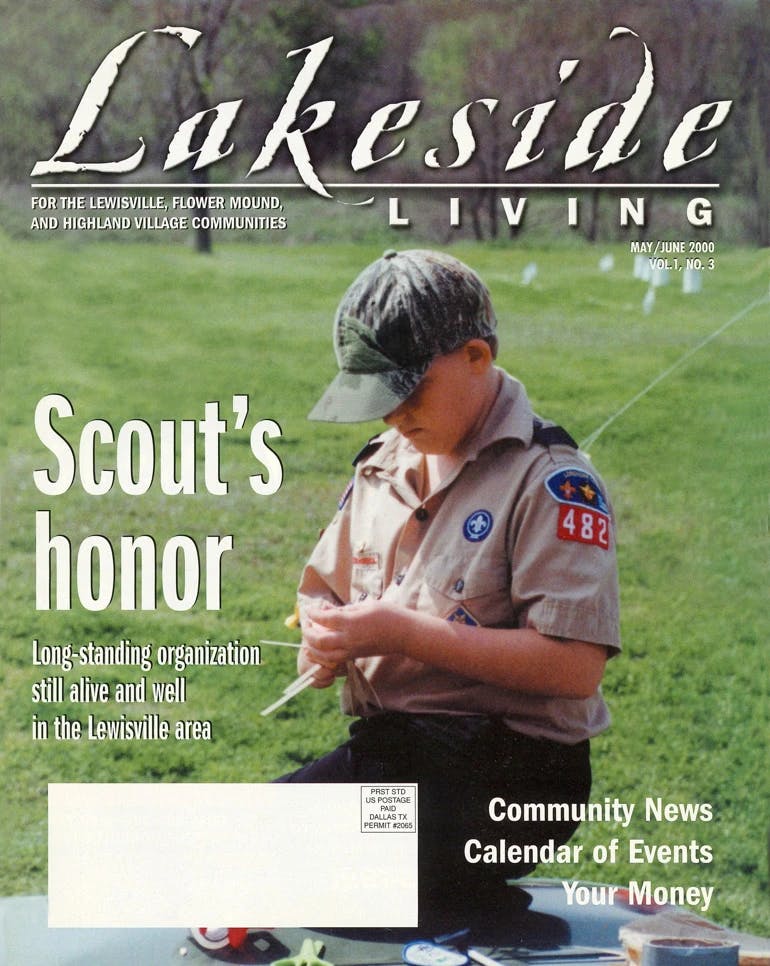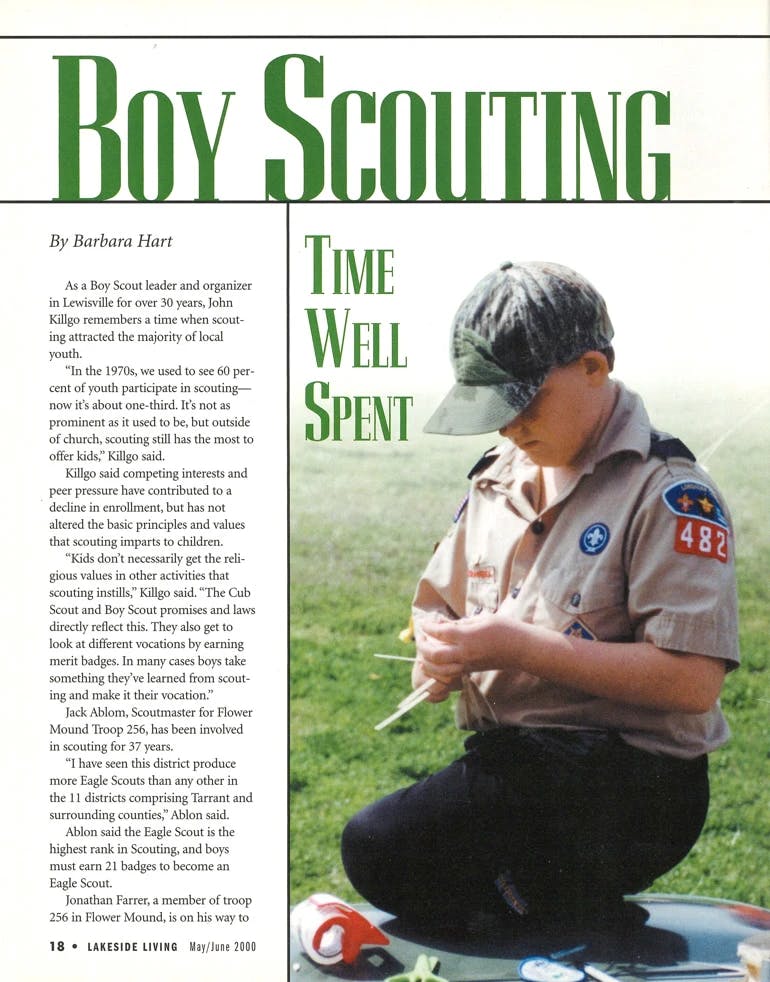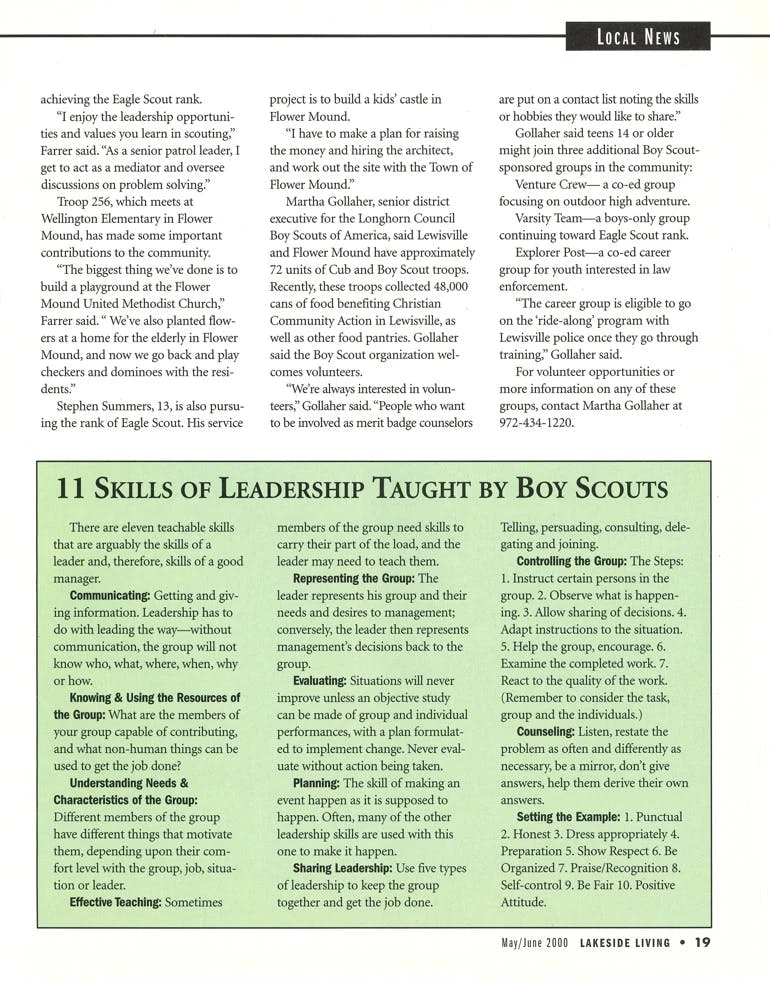Boy Scouting—Time Well Spent
As a Boy Scout leader and organizer in Lewisville for over 30 years, John Killgo remembers a time when scouting attracted the majority of local youth.
"In the 1970s, we used to see 60 percent of youth participate in Scouting – now it's about one-third. It's not as prominent as it used to be, but outside of church, scouting still has the most to offer kids,” Killgo said.
Killgo said competing interests and peer pressure have contributed to a decline in enrollment, but has not altered the basic principles and values that scouting imparts to children.
"Kids don't necessarily get the religious values in other activities that scouting instills,” Killgo said. "The Cub Scout and Boy Scout promises and laws directly reflect this. They also get to look at different vocations by earning merit badges. In many cases boys take something they've learned from Scouting and make it their vocation.”
Jack Ablom, Scoutmaster for Flower Mound Troop 256, has been involved in scouting for 37 years.
"I have seen this district produce more Eagle Scouts than any other in the 11 districts comprising Tarrant and surrounding counties," Ablon said.
Ablon said the Eagle Scout is the highest rank in Scouting, and boys must earn 21 badges to become an Eagle Scout.
Jonathan Farrer, a member of troop 256 in Flower Mound, is on his way to achieving the Eagle Scout rank.
"I enjoy the leadership opportunities and values you learn in scouting," Farrer said. "As a senior patrol leader, I get to act as a mediator and oversee discussions on problem solving."
Troop 256, which meets at Wellington Elementary in Flower Mound, has made some important contributions to the community.
"The biggest thing we've done is to build a playground at the Flower Mound United Methodist Church," Farrer said. "We've also planted flowers at a home for the elderly in Flower Mound, and now we go back and play checkers and dominoes with the residents."
Stephen Summers, 13, is also pursuing the rank of Eagle Scout. His service project is to build a kids' castle in Flower Mound.
"I have to make a plan for raising the money and hiring the architect, and work out the site with the Town of Flower Mound."
Martha Gollaher, senior district executive for the Longhorn Council Boy Scouts of America, said Lewisville and Flower Mound have approximately 72 units of Cub and Boy Scout troops. Recently, these troops collected 48,000 cans of food benefiting Christian Community Action in Lewisville, as well as other food pantries. Gollaher said the Boy Scout organization welcomes volunteers.
"We're always interested in volunteers," Gollaher said. "People who want to be involved as merit badge counselors are put on a contact list noting the skills or hobbies they would like to share."
Gollaher said teens 14 or older might join three additional Boy Scout-sponsored groups in the community:
Venture Crew--- a co-ed group focusing on outdoor high adventure.
Varsity Team--- a boys-only group continuing toward Eagle Scout rank.
Explorer Post--- a co-ed career group for youth interested in law enforcement.
"The career group is eligible to go on the 'ride-along’ program with Lewisville police once they go through training," Gollaher said.
For volunteer opportunities or more information on any of these groups, contact Martha Gollaher at 972-434-1220.
11 Skills Of Leadership Taught By Boy Scouts
There are eleven teachable skills that are arguably the skills of a leader and therefore, skills of a good manager.
Communicating: Getting and giving information. Leadership has to do with leading the way – without communication, the group will not know who, what, where, when, why or how.
Knowing & Using the Resources of the Group: What are the members of your group capable of contributing, and what non-human things can be used to get the job done?
Understanding Needs & Characteristics of the Group: Different members of the group have different things that motivate them, depending upon their comfort level with the group, job, situation or leader.
Effective Teaching: Sometimes members of the group need skills to carry their part of the load, and the leader may need to teach them.
Representing the Group:* The leader represents his group and their needs and desires to management; conversely, the leader then represents management's decisions back to the group.
Evaluating: Situations will never improve unless an objective study can be made of group and individual performances, with a plan formulated to implement change, Never evaluate without action being taken.
Planning: The skill of making an event happen as it is supposed to happen. Often, many of the other leadership skills are used with this one to make it happen. Sharing Leadership: Use five types of leadership to keep the group together and get the job done. Telling, persuading, consulting, delegating and joining.
Controlling the Group: The Steps: 1. Instruct certain persons in the group. 2. Observe what is happening. 3. Allow sharing of decisions. 4. Adapt instructions to the situation. 5. Help the group, encourage. 6. Examine the completed work. 7. React to the quality of the work. (Remember to consider the task, group and the individuals.)
Counseling: Listen, restate the problem as often and differently as necessary, be a mirror, don't give answers, help them derive their own answers.
Setting the Example: 1. Punctual 2. Honest 3. Dress appropriately 4. Preparation 5. Show Respect 6. Be Organized 7. Praise/Recognition 8. Self-control 9. Be Fair 10. Positive Attitude.



